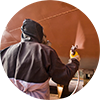
Do You Know When Work-related Burns Need Professional Injury Care?
First, the good news
The standard of care for burn injuries has improved substantially since the 1980s, contributing to a three-to-five-fold decline in burn-related deaths in the last 30 to 40 years.1 This is welcome news, especially in industries vulnerable to burns, such as food service, manufacturing, paper mills, utilities, firefighting, and shipbuilding. The U.S. Bureau of Labor Statistics reported that thermal and chemical burns occurred at a rate of fewer than 2 cases per 10,000 full-time employees (FTEs) in 2018.2 Burn injuries occur infrequently when you compare them to the incidence of other occupational injuries (cases per 10,000 FTEs): sprains, strains, and tears, 34; soreness and pain, 18.7; cuts, lacerations, and punctures, 9; and bruises and contusions, 8.8.3
So, if burn injury care is better and burn injuries are relatively rare, why be concerned about them?
Burn injuries are traumatic
A “traumatic injury” is a physical injury that occurs suddenly, is severe, and requires immediate medical attention. It can cause a systemic shock called shock trauma, where there is insufficient blood flow to cells and organs, possibly requiring resuscitation and life-saving interventions.
“Burn injuries are an under-appreciated trauma that can affect anyone, anytime, and anywhere. The injuries can be caused by friction, cold, heat, radiation, chemical, or electrical sources, but the majority of burn injuries are caused by heat (thermal) from hot liquids, hot solids, or fire,” reports the American Burn Association.4
For supervisors and coworkers, especially those who witness a burn injury as it’s happening, burn injury also is traumatic in the non-medical sense of the word; that is, it is psychologically or emotionally stressful and can cause serious distress and anxiety. This is due to the nature of burn injuries. They often happen suddenly and have the potential to cause lifelong disfigurement, if not death.
This article is intended to provide guidance on when to seek a medical evaluation for burns, a general overview of burn injury care at Concentra, and tips on preventing work-related burns. Before turning to those topics, let’s quickly review the major burn injury types, the current method for classifying burns, and why this article focuses on thermal burns.
Burn injury types and burn severity
There are four major types of burn injury.5
- Thermal (or heat) burns from contact with hot objects, boiling liquids, steam, or fire.
- Electrical burns from contact with live wires or other sources of electrical current.
- Chemical burns from exposure to strong acids, alkaloids, detergents, or solvents.
- Radiation burns from prolonged exposure to ultraviolet light, sun rays, or other sources of radiation.
Burn severity can be classified according to burn depth and/or the percentage of total body surface area (TBSA) affected.
Burn depth. Understanding burn depth is important because it has an impact on healing time, the need for hospitalization and surgical intervention. Burn depth classifications today are more descriptive than the former first, second, third, and fourth degree burn designations.
The American Academy of Family Physicians provides photos and graphic renderings.6 These may enhance your understanding of burn severity for each of the new designations below:
Superficial. See Figure 1.
Superficial partial thickness. See Figure 2.
Deep partial thickness. See Figure 3.
Full thickness. See Figure 4.
Total body surface area. TBSA also is important because it has an impact on quality of life and length of hospitalization.7 There are three main methods of estimating the area of surface area burns:
- The Wallace Rule of Nines.8 This method estimates body surface area burned by assigning percentages to different body areas, as specified here:
- Head – 9%
- Chest – 9%
- Abdomen – 9%
- Back – 18%
- Lower extremities – 36% (9% for the anterior portion of each lower extremity and 9% for each posterior lower extremity)
- The Lund and Browder Chart.9 This method also assigns values to body parts and involves mental calculations using fractions. If you want to learn more about this widely used method, the citation will take you to research published by the Journal of Acute and Critical Care that displays the original Lund and Browder chart and a modified chart that simplifies burn surface area calculations.
- Hand or Palm Surface Area (HSA or PSA).10 These methods use the size of the burn patient’s hand or palm to determine the percentage of body surface area burned.
Focusing on thermal burns
About 450,000 people in the United States get treated for burns each year, in and outside the workplace. About 30,000 people are admitted to burn centers, and 86 percent are treated for thermal burns.11 The workplace incidence of thermal burns was more than triple that of chemical burns and corrosions in 2018, according to the Bureau of Labor Statistics.12 Because they are predominant, thermal burns are the focus of this article.
Concentra has prepared a handy, two-page information sheet on thermal burns for employers. Please download a copy of “Approach to Thermal Burns in the Workplace."
When to seek medical evaluation for burns
Information on when a burn injury requires medical evaluation, as well as description of Concentra’s care of minor burns, are provided by Maja Jurisic, MD, CPE, vice president and medical director of Strategic Accounts.
Six instances when a burn injury requires medical attention are:
- The burn involves the face, hands or fingers, genitals, or feet
- The burn is on or near a joint (knee, shoulder, hip)
- The burn encircles a body part (arm, leg, foot, chest, finger)
- The burn is large (more than three inches in diameter) or deep (involves more than the top layer of skin). If in doubt, seek the advice of a health care provider.
- There are signs of infection (redness, pain, pus-like discharge, temperature greater than 100.4º F).
Care for relatively minor burns – those designated as superficial or superficial partial thickness – is available through Concentra Telemed™ and at all of Concentra’s more than 520 community-based medical clinics nationwide. Remember that even a minor burn is a recordable injury under Occupational Safety and Health Administration (OSHA) rules if treatment exceeds first aid care or the injury involves loss of consciousness, transfer to another job, or restriction from work.
Concentra care of minor burns: what to expect
The priorities in caring for minor burns include cleaning and cooling the affected area, preventing infection, and managing pain.
Cleaning the area. Any clothing is removed from the burn area and the burned skin is gently washed with cool tap water and soap.
Cooling the area. A cold compress may be applied to the cleaned area or the burned area may be soaked briefly to reduce pain and the extent of the burn. Avoid direct placement of ice, which can damage skin.
Preventing infection. Aloe vera lotion or an antibiotic cream, such as bacitracin, may be applied but ointment and other folk remedies like mustard, egg whites, lavender oil, emu oil, and toothpaste are to be avoided.
Managing pain. Swelling and pain of burns on the hands or feet can be eased by elevating the affected limb above the level of the heart when seated.
Guidance for preventing work-related burns
Burn prevention is an enormous topic with a multitude of safety strategies, many of them based on particular industry processes and equipment. But let’s leave you with three of the best strategies for all employers:
- Teach fire safety. Train all employees in how to use a fire extinguisher and make sure working extinguishers are placed throughout your work facility.13, 14
- Provide initial (pre-employment) safety training and periodic refresher training to employees in jobs where there is a risk of fire or explosion.
- Make sure the full complement of personal protective equipment (PPE) is actively worn and in good condition when PPE is required. Many burns result from not wearing all required PPE.
Conclusion
Burn injuries can leave scars for a lifetime, physically for the injured employee, and emotionally for the injured employee, coworkers and supervisors. Knowledge is the best defense because this is one time when keeping injury numbers low is not enough. Elimination of burn injuries is the goal.
Contact Concentra about injury care for minor burns at our convenient, community-based medical clinics. We also are happy to consult with you on how to reduce burn injury risk in your work facility and understanding more about the nature and treatment of all types and classifications of burn injuries.
NOTES
1 News release. American College of Surgeons. “Burn Specialists Report a Dramatic Increase in Burn Injury Survival Rate Over the Past 30 Years,” March 9, 2018.
2 2018 Survey of Occupational Injuries and Illnesses. Charts Package. Bureau of Labor Statistics. November 7, 2019.
3 2018 Survey of Occupational Injuries and Illnesses. Charts Package. Bureau of Labor Statistics. November 7, 2019.
4 2019 American Burn Association National Burn Repository Annual Report.
5 Ambulatory Management of Burns. American Family Physician. American Academy of Family Physicians.
6 Ambulatory Management of Burns. American Family Physician. American Academy of Family Physicians.
7 Kishawi D, Wozniak AW, Mosier MJ. TBSA and length of stay impact quality of life following burn injury. Burns. May 2020; 46(3): 616-620.
8 Moore RA, Waheed A, Burns B. “Rule of Nines” chapter in book StatPearls. July 10, 2020.
9 Murai A, Singh KN. Lund and Browder chart-modified versus original: a comparative study. Journal of Acute and Critical Care. November 2019; 34(4): 276-281.
10 Rhodes J, Clay C, Phillips M. The surface area of the hand and the palm for estimating percentage of total body surface area: Results of a meta-analysis. British Journal of Dermatology.
11 Schaefer TJ, Tannan SC. “Thermal Burns” chapter in book StatPearls. September 18, 2020.
12 2018 Survey of Occupational Injuries and Illnesses. Charts Package. Bureau of Labor Statistics. November 7, 2019.
13 Preventing Workplace Burns. Online OSHA Training. University of South Florida.
14 Mian MAH, Mullins RF, Alam B, Brandigi C, Friedman BC, Shaver JR, Hassan Z. Workplace-related burns. Annals of Burns and Fire Disasters. June 2011; 24(2): 89-93.



